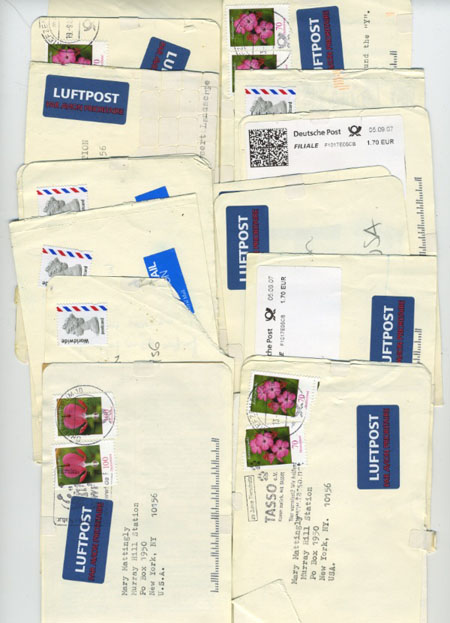![]() body | color | collections | commodity | cube | document | fabric | fetish | gender | glass | home | identity | living | machine | metal | minimal | mobility | narrative | olfactory | organic |
body | color | collections | commodity | cube | document | fabric | fetish | gender | glass | home | identity | living | machine | metal | minimal | mobility | narrative | olfactory | organic |
![]() pain | paper | plastic | plugs | power | protective | rectangular | ritual | round | sound | souvenir | spiritual | style | text-based | time | tool | touch | uniform | value | visual | warm | wood
pain | paper | plastic | plugs | power | protective | rectangular | ritual | round | sound | souvenir | spiritual | style | text-based | time | tool | touch | uniform | value | visual | warm | wood
| Correspondence: Stamped and Mailed Envelopes | |||
Narrative: Rolls of paper, typically weighing 220 lb are either cut before they enter the automated machine that makes the envelopes, or fed directly into the machine from the roll. Once cut, the sheets are stacked and cut into blanks. A blank has the shape of an envelope with its flaps opened and laid flat. Shaped like diamonds and cut from the sheets in such a way as to minimize waste. The glue applied to the flap that is sealed by the consumer is usually a gum. A typical natural gum is gum arabic, derived from a substance produced by the acacia tree. Synthetic gums are often derived from dextrans, which are produced by the fermentation of sugar. The glue that holds the rest of the envelope must be stronger and more permanent. This glue is often derived from starches, which are obtained from corn, wheat, potatoes, rice, and other plants. The completed envelopes are filled in cardboard boxes and shipped to retailers. Sticker postage stamps, ink-based stamps, and airmail stickers still need to be accounted for here. Text was typed on a typewriter and pencil drawn. Graphite combined with clay and wax or other chemicals make up the center of the pencil. The wood used to manufacture pencils must be able to withstand repeated sharpening and cut easily without splintering. Most pencils are made from California cedar. Some pencils have erasers, which are held on with a ferrule, a metal case that is either glued or held on with metal prongs. The erasers themselves consist of pumice and rubber. Typewriters use hundreds to thousands of moving parts. Carrying case is made of steel and plastic. Steel is the material used for most of the parts in standard models. The platen is a steel tube covered with a rubber sleeve. The rubber sleeves are made of a special form of rubber from the "buna-N" family. Glue is used to adhere the rubber sleeve to the platen tube. The keys are molded of plastic in a two-shot, injection-molding process that made white characters with the surrounding key tops in other colors. From the 1970s forward, a pad printing process has been used to apply the characters in ink and coat the keys with a clearcoat finish. Mylar ribbons with ink on one side are used to transfer the typeface. These ribbons are contained in plastic cartridges that could be thrown away. Miscellaneous materials are also used. These include glue, paint, chemical solvents and other fluids, zinc and chromium for plating some components, and acetic acid for building protective coatings on some parts. I saved these letters from a correspondence with artist Veronica Flores. We met in Oxfordshire, England at a residency and planned a project together in her hometown in Guadalajara, Mexico. These were the letters she sent me over the span of a few months while we were composing a journey by bicycle from Guadalajara to Mexicaltitan, Mexico. |
 |
||
![]()
